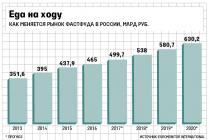The very idea that the authorities provide services to citizens is certainly true, as is the principle of providing services on the basis of a task formulated by a state or municipal authority. With the right approach to the calculation of the cost of a service, the formation of a task for the provision of a service, the definition of requirements for the quality of the provision of a service, it becomes possible to put up tasks for the provision of services for bidding. And not only state and municipal budgetary, autonomous and state-owned institutions, but also businesses should be allowed to participate in the auction.
Electronic doesn't mean cheap
Lately, one often hears that electronic services should be cheaper than services provided in the traditional way. And, characteristically, such statements are not supported by any arguments. And the cost of the service you just need to take and calculate.
Let's start with a few postulates. So that the rights of citizens are not infringed, any service must be provided on the basis of a standard. Those. The main point of the standard is that in any part of the country the same service is provided in the same volume and with the same requirements for the provision of the service. The standard should include:
- description of the service, including its volume in physical terms;
- terms of service provision;
- quality indicators and evaluation of the results of the service;
- conditions for the provision of the service, including - free of charge or on a paid basis, or with partial payment,
- other provisions necessary for the provision of the service, for example, compliance with the requirements of the law, SanPiNs, GOSTs, ensuring the requirements for premises, necessary equipment, etc.
Based on the standard and the requirements formulated in it, as well as volumes in physical terms, the standard cost of providing the service is calculated (for example, per capita). This standard will be used when planning budget costs for the provision of services, as well as when determining the fee for the service when providing services on a paid basis, both with full and partial payment.
Thus, the existence of a standard is a key point in calculating the cost of a service. Without a standard, namely the volumes defined in it in physical terms, it is impossible to calculate the cost of a service. And with them - it is possible, and even easy. The time of work of the specialists involved in the provision of the service, the availability of special equipment, furniture, special equipment, consumables, overhead costs of the institution necessary for the provision of the service, etc. are taken into account. Moreover, it should be taken into account that the standard for the provision of services should be adopted for the industry as a whole, and not for each individual institution. For example, educational standards should be adopted for all schools, and not for each one separately. The standard is the standard, that it is one and obligatory for all. It is impossible to adopt a standard in the field of education at the municipal level. And the normative cost of providing a service, calculated according to the standard, may be different for different institutions, I admit that even in the same municipality. For example, in the field of education, this depends on the level of salaries of teachers, which in turn depends on whether the school is rural or urban, or specialized for children with developmental delays, class occupancy, regional wage coefficient, etc. For example, the cost of meals for schoolchildren in Kamchatka and in central Russia is not the same, and this does not surprise anyone. The rendered state service can also cost differently. So, in my opinion, it is absolutely wrong to include a standard for the cost of a service in the standard for its description.
For example
With the development of standards for services, we, to put it mildly, are not doing very well. Until now, there are no clear unified lists of state and municipal services. Accordingly, with the calculation of the cost of services, the situation is even worse.
Let's try to understand the cost and formation of the state task using the example of social services. Most of what will be said below can be generally attributed to any service, even in the field of education, even in the field of medicine, as well as other state and municipal services.
On December 28, 2013, federal law N442-FZ “On the Fundamentals of Social Services for the Population in the Russian Federation” was adopted, some of the provisions of which, from the point of view of the foregoing, are not entirely logical. For example, the adoption of standards for social services has been delegated to the level of constituent entities of the Russian Federation, although the justification for the adoption of this law indicated precisely that it was intended to eliminate inequality in the provision of social services from region to region. Well, if the regulator wants it that way, so be it. Although I have a number of assumptions, which I will express at the end of the article, why this is done. Otherwise, the law is quite sane and its adoption is only welcome.
In the field of calculating the standards for state and municipal services and the formation of state / municipal assignments, we will be guided by two documents - the joint order of the Ministry of Finance No. 137n and the Ministry of Economic Development No. 527 dated October 29, 2010 "On methodological recommendations for calculating the standard costs for the provision of public services by federal state institutions and the standard costs for maintaining the property of federal state institutions", and also, since we live in the Sverdlovsk region, the decree of the government of the Sverdlovsk region dated October 29, 2010 February 8, 2011 No. 76-PP "On the procedure for the formation of the state task in relation to state institutions of the Sverdlovsk region and financial support for the implementation of the state task."
I will tell you very briefly what approach, using information technology, we are implementing when calculating service standards and forming a state assignment in the field of social services.
The standards for the cost of services themselves are an integral part of the multi-stage technology within the framework of the implementation of 442-FZ. These steps can be summarized in the following table:
|
Description stage |
Note |
|
|
Approval by the subject of the Russian Federation listsocialservices |
Formed scroll concrete social services, being guarantee And expendable obligation states before citizen (at availability at last individual needs) |
|
|
Adoption statestandard for each service included in the list of social services |
State standard V composition order providing services determine guaranteed volume each services, incoming V scroll social services, That There is What from myself is specific service How "resource— process— result" or How lot, which Maybe be exhibited on free bargaining And subjected to subsequent control performance |
|
|
Inclusion of social services in regional social service programs |
Volume resources, included V regional programs, formed proceeding from from predictable needs V services And per capita standards funding on every service, included V scroll, which calculated on basis state standard on services |
|
|
Bringing the state task, or open competitive placement of an order for the execution of activities of the regional program (for the provision of state social services) |
list purchased services will become scroll social services, A technical task By each service state standard. Contractor on competitive basis Maybe become organization any forms property |
In fact, the stages are identified purely formally, and when solving the problem in a complex, you will have to repeatedly move from stage to stage, making several iterations.
As mentioned earlier, the standards for the cost of services cannot be calculated without standards. I previously wrote about the current situation with standards in the field of social services with the article "", I will not repeat myself, I will only remind you of the conclusion: it is not possible to apply these standards in practice, for a number of reasons.
As an initial list of services and draft standards in the field of social services, we take the information located. Practitioners have been working on these draft standards for more than a year and a half, they are still open for public discussion and on the website (as far as I know, not the latest versions are posted). So I personally have no complaints about the content of the standards, the only task is to normalize this information for placement in the database, especially in terms of natural standards.
From the information provided, it can be seen that the structure of the standard reflects the requirements of the adopted law and, on an enlarged basis, consists of the following sections:
- Form of social service: ...
- Type of social service: ...
- Name of social service: ...
- Recipient Category: …
- Service quality:…
- Guaranteed level of service: ...
|
Orderrenderingservices (compoundAndelementsservices) |
Volumeproviding |
Conditionsrenderingsocialservices, determiningqualitysocialservices |
|
1. standardprovidingservices: … 2. Periodicityprovidingservices: … 3. Unitservices: … 4. per capitastandardfundingsocialservices (normativepriceservices): … |
1.Conditionsaccommodationinstitutions: … 2. staffinginstitutionsspecialistsAndtheirqualification: … 3. SpecialAndpersonneltechnicalequipmentinstitutions (equipment, appliances, equipmentAndT. d.): … |
Services, if you count the above reference to the draft standards and their elements - simple servants (sub-services), it turns out about a thousand. There are about 150 institutions providing services. Naturally, different institutions provide different, but overlapping, sets of services. All services from the list of services, probably, are not provided by any institution.
Now about the technology used to calculate the standard cost of the service. It is carried out in several stages.
The first stage is preparatory. Information is collected from all institutions in a number of forms, including plans for financial and economic activities, staffing, planned volumes of services (based on statistics from previous years and based on draft standards). A number of forms are also subject to collection with estimated costs for the provision of each sub-service described by the standard in different sections. Today, due to the fact that the list of standards is new, the services provided differ from those indicated in the list. There are likely to be some complexities associated with allocating agency costs to services. Here, attention should also be paid to the fact that even within the same institution, the same service can be provided by different departments. Accordingly, with different costs for the provision of services, due to different overhead costs.
The next step of the preparatory stage is to import data into a centralized repository and check them for reliability according to some control ratios, for which FCD plans and staffing tables are used, as well as other financial information, for example, reports on the execution of a state task for previous periods.
The second stage - based on the received data warehouse, OLAP cubes are built and Data Mining tools are used, including data cleaning and methods of mathematical statistics, and intellectual analysis is carried out with “what if” elements. At this stage, the analyst (economist or financier) uses various data visualization tools. The ultimate goal of this analysis is to derive standards for each service for a group of services or a group of institutions through the solution of intermediate tasks:
- allocation of services of the same type in terms of composition of costs, to which the principle of cost formation can be applied on the basis of a standard hour, a conditional unit of service, etc.;
- allocation of the same type of groups of institutions and signs of their association for the introduction of standards for groups of institutions (territories) with differentiated conditions (for example, urban-rural);
- determination of standards in selected groups and processing of deviations of values calculated by institutions;
- and so on.
Naturally, the quality of the analyst's work comes to the fore here.
Now, having the cost of each service for each institution and multiplying it by the planned volume of its provision, we get the estimated budget costs.
This is exactly what, in my opinion, is the deterrent to the adoption of service standards at the federal level. Everyone understands (and fears) that if such a calculation is made, the budget costs will increase by an order of magnitude, or even more. Let's try to avoid this in a civilized way.
How to avoid rising service costs
The third stage is balancing the budget. Initially, the cost was calculated on the assumption that all our services are guaranteed, i.e. are donated to the population at the expense of the budget. How can we “play” already having calculated standards?
The first is the right to free public services. Paid, free, partial payment for services for various categories of recipients of social services. Here it is necessary to take into account the requirements of the law. Those. there are such categories as war and combat veterans, the disabled, etc., where the requirements for guarantees in obtaining social services are directly determined by law. Also, an example of direct legislative regulation can be children in a difficult life situation, who always receive guaranteed social services free of charge.
Second. The list and composition of guaranteed services, including sub-services. For example, the service “assistance in cleaning and repairing a dwelling” may include washing floors, washing windows, wet cleaning, etc. So, let's say washing floors can be free, and washing windows is only paid for all categories.
Third. Rough application of the coefficient derived from the possibilities of the budget to the calculated standards. I wouldn't recommend using this.
Fourth. The volume of services included in the state task. Also a kind of self-deception. Approved the standard, knowing in advance the underestimated volume of services. And then at the end of the year we urgently look for money. From this decision, let's say that the number of homeless people on the street will not decrease, and assistance within reasonable limits - to wash, feed, let them spend the night temporarily, help in restoring documents will still have to be provided to all identified and applied.
There may be other options. Here the decision-making depends on the specific situation, both social, financial and political, and in each specific case it can be different.
These are the principles we are laying in the definition of the standard cost of services in the software product we are currently developing. At the output of it, the following documents should be obtained (files for exchange with other information systems):
- Annexes to the regulatory legal acts (NLA) of the subject of the federation on the list of social services provided
- Application (file for import into other information systems) to the regulatory legal acts of the subject of the federation with standards of social services
- Annex to the NPA of the subject of the federation for the approval of per capita standards for the provision of social services
- Annex (file for import into other information systems) to the NPA of the subject on the approval and completion of the state task for each institution
- Determination of the amount of the subsidy for each institution for the maintenance of the institution.
It should also be noted that this approach, in principle, makes it possible to form a state task separately for each institution in the context of each sub-service provided by the institution. But it is difficult to do this right away, without having statistics on the provision of services in the context of standards. Therefore, at the initial stage, the state task can be brought up on an enlarged basis, for example, by aggregating it according to the forms of social services.
Estimated release date of the beta version of the information system, tested on real data, providing the above functionality, is expected in March-April 2014.
Not all services can become electronic
In conclusion, I would like to say a few more words about the limitations faced by the transfer of services to electronic form. First of all: not all services can be translated into this form. The provision of the bulk of social services requires a specialist and appropriate infrastructure. Take, for example, a home delivery service. And the transfer of services into an electronic form of services, falls above on the cost. According to my estimates, only 15-30% of services can become fully electronic. In order for more services to become truly electronic, it is necessary to finally legally resolve the issue of using electronic documents. In the meantime, in most cases it is more correct to talk about an electronic application for a service.
Of course, the introduction of even pseudo-electronic services achieves a certain economic effect, for example, from reducing the cost of queuing in various state and municipal institutions.
Final remarks
Calculating the cost of services, even those provided in the traditional form, is a complex task that requires the use of the most modern methods of information analysis, and, accordingly, the availability of specialists who own these methods.
The task of developing standards, and even more so regulations, at the federal level is not at all trivial, and requires the use of other methods that are different from those discussed in this article. However, the tools used in the analysis remain the same. There would be enough qualifications from civil servants involved in this process. Which I personally doubt. I would be very happy to be wrong.
In order to implement Art. 8 of the Federal Law of December 28, 2013 No. 442-FZ "On the basics of social services for citizens in the Russian Federation"
I ORDER:
1. Approve tariffs for social services based on per capita norms for financing social services, in accordance with Annexes 1-4 to this order.
2. Heads of departments and divisions of the Department, heads of departments of social protection of the population of administrative districts should be guided in their further work by the approved tariffs.
3. Heads of departments and departments of the Department, heads of departments of social protection of the population of administrative districts to bring this order to the heads of subordinate state institutions for use in further work.
4. To impose control over the execution of this order on the deputy heads of the Department for areas of activity.
Tariffs for social services provided to citizensin the form of social services at home
|
Average time to complete 1 social service |
for a service without VAT, rub. |
||
|
1. Social services |
|||
|
purchase and delivery at the expense of the recipient of social services to the home of food, hot meals from trade organizations | |||
|
help with cooking | |||
|
help with eating | |||
|
purchase and delivery at the expense of the recipient of social services to the home of essential goods | |||
|
assistance with house cleaning | |||
|
delivery of water, heating of stoves, assistance in providing fuel (for those living in residential premises without central heating and (or) water supply) | |||
|
delivery of things for washing, dry cleaning, repair and their return delivery at the expense of the recipient of social services | |||
|
Assistance in organizing the repair of the premises and its subsequent comprehensive cleaning | |||
|
assistance in making payments for housing and utilities, communication services (including taking readings from metering devices for the consumption of heat energy, hot and cold water, gas, filling out receipts, paying bills) | |||
|
assistance in organizing the provision of services by trade organizations, organizations providing utilities and communication services, as well as other organizations providing services to the population | |||
|
delivery of books, purchase of newspapers and magazines at the expense of recipients of social services | |||
|
Subscribing to newspapers and magazines at the expense of recipients of social services | |||
|
assistance in visiting theaters, exhibitions and other cultural events | |||
|
short term babysitting | |||
|
Assistance with funeral paperwork | |||
|
promoting health-based care | |||
|
health monitoring | |||
|
provision of primary pre-medical health care in an emergency form | |||
|
performing medical procedures, dressings, injections as prescribed by the attending physician | |||
|
provision of sanitary and hygienic services | |||
|
assistance in providing medical care | |||
|
assistance in conducting medical and social expertise | |||
|
assistance in carrying out rehabilitation activities (medical, social), including for the disabled, on the basis of individual rehabilitation programs | |||
|
assistance in providing the necessary technical means for the rehabilitation of a disabled person | |||
|
assistance in providing, according to the conclusion of a medical organization, medicines and medical devices | |||
|
visits to recipients of social services who are in medical organizations in stationary conditions | |||
|
assistance in obtaining vouchers for sanatorium treatment | |||
|
3. Social and psychological services |
|||
|
Providing psychological assistance | |||
|
4. Social and educational services |
|||
|
assistance in obtaining education and (or) a profession for disabled people, taking into account the peculiarities of their psychophysical development, individual capabilities | |||
|
5. Social and labor services |
|||
|
employment assistance | |||
|
6. Social and legal services |
|||
|
employment assistance | |||
|
Social and legal services | |||
|
assistance in obtaining social support measures, including benefits | |||
|
assistance in obtaining free legal assistance in the manner prescribed by law | |||
T tariffs on social services provided to citizens in a semi-permanent form of social service at home
|
Name of the social service |
The average norm of time for the performance of 1 social service |
for a service without VAT, rub. |
|
|
1. Urgent social services |
|||
|
provision of free hot meals or a set of products | |||
|
provision of one-time assistance in the form of food packages, clothes, shoes and essentials | |||
|
provision of clothing, footwear and other essentials | |||
|
assistance in obtaining temporary housing | |||
|
assistance in obtaining emergency psychological assistance with the involvement of psychologists and representatives of traditional religious denominations in this work | |||
|
organization of emergency psychological assistance | |||
|
assistance in obtaining legal assistance in order to protect the rights and legitimate interests of recipients of social services | |||
|
provision of one-time services to citizens in need of a one-time provision of social services | |||
|
provision of socio-economic support to children and families with children (clothes, food and other assistance) | |||
|
2. Social services |
|||
|
catering, household and leisure services | |||
|
providing hot meals |
1 service per day | ||
|
organization of cultural and leisure events | |||
|
provision of temporary stay in social service organizations | |||
|
provision of furniture | |||
|
providing in-kind assistance in the form of clothing and footwear | |||
|
provision of bedding and other accessories | |||
|
leisure activities (books, magazines, newspapers, board games, etc.) | |||
|
purchase of railway tickets for travel to the former place of residence (if needed) | |||
|
assistance in organizing recreation and recreation for children | |||
|
3. Social and medical services |
|||
|
provision of first pre-medical medical and sanitary aid | |||
|
organization of medical and recreational activities | |||
|
provision of medical and social care taking into account the state of health of the recipient of social services | |||
|
assistance in passing the examination in the institutions of medical and social expertise | |||
|
organizing medical examinations | |||
|
assistance in hospitalization in medical organizations, escort to medical organizations | |||
|
4. Social and psychological services |
|||
|
assistance in obtaining psychological assistance | |||
|
providing psychological support, conducting psycho-correctional work | |||
|
assistance in the restoration of social ties | |||
|
support for further life | |||
|
assistance to parents in the upbringing of children, including assistance in conflict situations | |||
|
provision of comprehensive psychological and pedagogical assistance | |||
|
social patronage of families with children who are in a socially dangerous situation | |||
|
social patronage of orphans and children left without parental care, graduates of organizations for orphans and children left without parental care, under the age of 23 | |||
|
5. Social and educational services |
|||
|
carrying out activities to restore professional skills | |||
|
assistance in vocational training | |||
|
assistance to minors in matters of vocational guidance, education and employment | |||
|
6. Social and labor services |
|||
|
employment assistance | |||
|
7. Social and legal services |
|||
|
assistance in paperwork, excluding cases of paperwork affecting the interests of third parties, assistance in writing letters | |||
|
assistance in obtaining free legal aid | |||
|
assistance in the restoration of lost documents | |||
|
assistance in organizing pensions and providing other social benefits | |||
|
assistance in the preparation of documents for placement in the organization of stationary social services | |||
|
assistance in registration as those in need of residential premises | |||
|
assistance in the restoration in court of the rights to illegally alienated residential premises | |||
|
assistance in representation in court in order to protect the rights and interests | |||
|
8. Services to increase the communication potential of recipients of social services, with disabilities, including children with disabilities |
|||
|
training of persons with disabilities (disabled children) in the use of care products and technical means of rehabilitation | |||
|
carrying out social and rehabilitation measures in the field of social services | |||
|
training in behavior skills in everyday life and public places | |||
|
assistance in teaching computer literacy skills | |||
1 for persons attending day care units for pensioners and the disabled
2 for juveniles attending day care units for children and adolescents
3 for persons without fixed residence
Tariffs for social services provided to citizens in all forms of social services at home
|
Name of the social service |
The average norm of time for the performance of one social service |
for a service without VAT, rub. |
|
|
1. Social services |
|||
|
cooking hot food | |||
|
household help (washing dishes, taking out the trash) | |||
|
accompaniment on trips around the city by public transport | |||
|
general cleaning of the premises by means of the client: | |||
|
wet cleaning of all types of flooring | |||
|
cleaning of persistent dirt from moisture-resistant walls (bathroom and toilet rooms, "apron" in the kitchen) | |||
|
cleaning furniture from dust throughout the apartment | |||
|
cleaning of carpets, rugs, carpets with a vacuum cleaner of the client throughout the apartment | |||
|
cleaning sinks in the kitchen and bathroom, cleaning the bathtub and toilet | |||
|
cleaning the stove: without oven; with oven 60 minutes | |||
|
skirting board cleaning | |||
|
wiping doors, doorways in the apartment | |||
|
one window cleaning | |||
|
insulation of one window with window insulation (customer's funds) | |||
|
minor repair of clothes, linen | |||
|
ironing | |||
|
accompaniment for a walk | |||
|
provision of motor transport services to the organization (by reservation) | |||
|
reading periodicals and fiction | |||
|
2. Social and medical services |
|||
|
haircut | |||
|
change of bed linen | |||
|
change of underwear | |||
|
medical and physical culture complex | |||
Document provided by ConsultantPlus
THE GOVERNMENT OF MOSCOW
DEPARTMENT OF SOCIAL PROTECTION OF THE POPULATION
MOSCOW CITIES
dated 01.01.01 N 1033
ON THE PROCEDURE FOR DETERMINING TARIFFS FOR SOCIAL SERVICES
BASED ON PER CAPITA FINANCING STANDARDS
SOCIAL SERVICES
In order to implement Art. 8 of the Federal Law of 01.01.01 N 442-FZ "On the basics of social services for citizens in the Russian Federation" I order:
1. Approve the procedure for determining tariffs for social services based on per capita norms for financing social services (annex to this order).
2. Heads of departments and divisions of the Department, heads of departments of the population of administrative districts should be guided in their further work by the approved Procedure.
3. Heads of departments and departments of the Department, heads of departments of social protection of the population of administrative districts to bring this order to the heads of subordinate state institutions for use in further work.
4. To impose control over the execution of this order on the deputy heads of the Department for areas of activity.
Head of department
Application
to the order of the Department
social protection of the population
Moscow city
dated 01.01.01 N 1033
DETERMINATION OF TARIFFS FOR SOCIAL SERVICES ON THE BASIS
PER CAPITA FINANCING STANDARDS FOR SOCIAL SERVICES
1. General Provisions
1.1. This Procedure has been developed in accordance with:
1.8. When determining the tariff, the profit amounting to 5% of the cost of the social service was taken into account.
1.9. When calculating the cost of social services, the following costs were not included in the calculation:
For the purchase of unique and expensive equipment.
2. Determination of tariffs for social services based on
per capita financing standards
2.1. The tariff for the relevant social service, calculated on the basis of per capita financing norms, is determined by summing up the economically justified cost and profit according to the formula:
Tsu i = SBsu i + P i, where (1)
Tsu i - tariff for the i-th social service;
SBSU i - the cost of the i-th social service;
П i - the necessary profit received by the supplier through the implementation of the i-th social service.
3. Calculation of the cost of the i-th social service
3.1. Calculation of the cost of the i-th social service (SBSU i) is carried out according to the formula:
SBsu i = Рpr i + Рkosv i, where (2)
Рpr i - direct costs directly related to the provision of the i-th social service;
Rkosv i - indirect costs incurred by the provider in the process of providing the i-th social service.
3.2. Direct costs (Рpr i) include costs directly related to the provision of social services to the recipient:
5.3. The standard costs for the purchase of soft inventory (Zmi i) for a social service are determined by the following formula:
Zmi i = ZPvr i x Kpr, where (9)
The ratio of the cost of purchasing soft inventory to the payroll fund for personnel directly involved in the provision of the i-th social service.
The cost of acquiring soft goods for social services provided in a stationary (semi-stationary) form is determined based on the approved natural consumption norms and average market prices.
The costs of purchasing soft equipment for social services provided in the form of social services at home are determined in accordance with the current legislation.
5.4. Other general business expenses (Zpr i) include the following types of expenses:
(Zpr i) = Зс i + Зт i + Зк i + Зм i, where (10)
Zc i - costs for the provision of communication services directly used in the process of providing the i-th social service, which include:
Compensation for communication to social workers providing social services;
Connecting and using the Internet;
Forwarding postal items, making postal money transfers;
Purchase of postage stamps, envelopes;
Other similar expenses;
Zt i - transportation costs directly used in the process of providing the service, which include:
Compensation for travel to social workers providing social services;
Payment for contracts for the provision of transport services for the rental of vehicles;
Other similar expenses;
Zk i - utility costs incurred by the provider of social services directly in the provision of the i-th social service;
Zm i - the cost of purchasing inventories used directly in the provision of the i-th social service, including the cost of purchasing office supplies and other material assets.
5.5. General business expenses are determined by the structural method using the following formula:
Zpr i = Zpvr i x Kpr, where (11)
ZPvr i - labor costs and accruals for wage payments of personnel directly involved in the provision of the i-th social service;
The ratio of expenses for general business expenses to the payroll fund for personnel directly involved in the provision of the i-th social service.
6. Calculation of the cost of social services in part
indirect costs
6.1. Indirect costs include those types of costs incurred by the social service provider for the implementation of the main activity, but which cannot be included in the cost of social services using the direct calculation method.
6.2. Indirect costs in the provision of social services include:
Salaries of managerial and general economic personnel;
Accruals for the remuneration of managerial and general economic personnel, which are determined in accordance with tax legislation;
Communication services (postal services, telephone, telegraph, facsimile and other types of communication services; use of the Internet information and telecommunications network; other similar expenses);
Transport services;
Utilities (heating, electricity consumption, gas consumption, water disposal, payment for technological needs and other similar expenses);
Works, services for the maintenance of property (sanitary and hygienic services: deratization, disinfection, maintenance of technical equipment and other similar expenses);
Other works, services (installation and installation of local computer networks; production and (or) purchase of blank products; services in the region and other similar expenses);
Acquisition of inventories (expenses for fuel and lubricants, office expenses and other inventories).
6.3. In the cost of social services, indirect costs are included through the coefficient of indirect costs in proportion to direct costs.
Rkosv i = Рpr i x Kcr, where (12)
Rkosv i - the amount of indirect costs included in the cost of a specific i-th social service (rubles);
Рpr i - for the i-th social service (rubles);
Kcr - coefficient of indirect costs.
6.4. The coefficient of indirect costs (Kcr) is determined by the formula:
Kcr \u003d SUM Rkosv / SUM Rpr, where (13)
SUM Rkosv - the amount of indirect costs incurred by the supplier in the process of carrying out the main activity of providing social services to recipients of social services;
SUM Rpr - the amount of direct costs incurred by the supplier in the process of carrying out the main activity of providing social services to recipients of social services.
Federal Law "On the Fundamentals of Social Services for Citizens in the Russian Federation" The Government of the Russian Federation decides:
2. Establish that per capita norms for financing social services can be used to determine the amount of funding for the provision of social services in various forms of social services when forming the budget of a constituent entity of the Russian Federation, as well as to determine the amount of compensation paid to social service providers specified in Part 8 of Article 30 of the Federal Law "On the Fundamentals of Social Services for Citizens in the Russian Federation".
3. To the Ministry of Labor and Social Protection of the Russian Federation, together with the Ministry of Finance of the Russian Federation, to provide clarifications on the application of guidelines approved by this resolution.
1. This document has been developed to assist the constituent entities of the Russian Federation in determining a methodological approach to setting per capita financing standards for social services (hereinafter referred to as per capita financing standards).
2. Per capita financing standards are established per one recipient of social services included in the list of social services provided by social service providers, approved by the law of the constituent entity of the Russian Federation.
3. Per capita financing standards may be set by the constituent entities of the Russian Federation in a differentiated manner for urban and rural areas, depending on the forms of social services.
4. Per capita financing standards are determined on the basis of direct and indirect costs for the provision of social services for the period (at least one year) preceding the settlement period, using the index of price growth (tariffs) for the relevant goods and services.
5. Direct expenses for the provision of social services include expenses that depend on the number of recipients of social services and are directly related to the provision of a social service to its recipient, which include:
a) labor costs and accruals for wage payments for personnel providing social services;
b) general business expenses directly related to the provision of a social service to its recipient (expenses for the provision of communication services, utilities and transport services, material costs, etc.);
c) other expenses directly related to the provision of social services.
6. Indirect costs for the provision of social services include the costs necessary for the provision of social services, which cannot be taken into account in the cost of social services using the direct calculation method (since they do not depend on the number of recipients of social services) and which include:
a) labor costs and accruals on payments for the remuneration of managerial personnel;
b) general business expenses necessary to meet the own needs of the social service provider.
7. The per capita norm for financing the i-th social service () is calculated by the formula:
![]() ,
,
The amount of direct costs for the provision of the i-th social service;
The value of indirect costs for the provision of the i-th social service.
8. The amount of direct costs for the provision of the i-th social service () is calculated based on the value (on average for the subject of the Russian Federation) of the costs of state social service organizations indicated in paragraph 5 of this document for the provision of the i-th social service according to the formula:
Accruals on wage payments for personnel providing the i-th social service, established as a percentage of labor costs in accordance with the legislation of the Russian Federation;
Direct general business expenses directly related to the provision of the i-th social service;
Other expenses directly related to the provision of the i-th social service.
9. The amount of indirect costs for the provision of the i-th social service () is calculated by the formula:
![]() ,
,
The amount of indirect costs included in the cost of social services that cannot be taken into account by the direct calculation method;
Coefficient of indirect costs included in the cost of the i-th social service.
10. The amount of indirect costs included in the cost of social services () is calculated by the formula:
Labor costs for management personnel, determined based on the number of staffing units, taking into account the current wage system and actual accruals for the previous year;
Accruals on payments for salaries of management personnel, established as a percentage of labor costs in accordance with the legislation of the Russian Federation;
Indirect general business expenses, including the costs of paying for works (services) necessary to meet the social service provider's own needs.
11. The coefficient of indirect costs included in the cost of the i-th social service () is calculated by the formula:
![]() ,
,
where - the value of direct costs for the provision of the i-th social service.
12. The amount of direct general business expenses directly related to the provision of the i-th social service () is calculated by the formula:
![]() ,
,
General running costs;
Coefficient of attributing general business expenses to direct expenses directly related to the provision of the i-th social service.
13. General business expenses () include expenses for the provision of communication services, utilities and transport services, as well as material costs and other expenses and are calculated according to the formula:
Expenses for the provision of communication services;
Expenses for the provision of public services;
material costs;
Expenses for the provision of transport services;
Other expenses.
14. The ratio of attributing general business expenses to direct expenses directly related to the provision of the i-th social service () is determined by the formula:
![]() ,
,
Labor costs for personnel providing the i-th social service, determined based on the number of units according to the staffing table, taking into account the current wage system and actual accruals for the previous year;
The cost of salaries for management personnel, determined based on the number of units on the staff list, taking into account the current system of remuneration and actual accruals for the previous year.
e) other works (services), including works (services) for the maintenance of property (sanitary and hygienic maintenance - deratization, disinfection, garbage removal, technical maintenance of technical equipment, current repairs of buildings and equipment, vehicle repairs and other similar expenses), installation and assembly of local computer networks, security and fire alarm systems, video surveillance, access control, as well as services of non-departmental, fire protection, insurance services, manufacturing and (or) purchase of blank products and services in the field of information technology .
17. Expenses for the provision of communication services, incurred both for the provision of social services to the recipient of social services, and to meet the own needs of social service providers, may include expenses for the rental of technical equipment, telephone communications, cellular communications, connection and use of the Internet information and telecommunications network, access to the telephone network (installation of telephones), long-distance and international connections, local telephone connection (subscriber and time-based payment), radio communications and other means of communication, use of a radio point, as well as expenses associated with forwarding postal items , postal money transfers, and other similar expenses.
18. Transportation costs of social service providers may include the costs associated with the provision of transport services to ensure the travel of the recipient of social services or to meet the own needs of the social service provider.
19. Expenses of social service providers for paying for contracts for the provision of utility services for the provision of social services to recipients of social services or for the provision of the social service provider's own needs may include costs for heating and technological needs, consumption of gas, electricity, water supply, sewerage, sewage, etc.
20. Material costs in the provision of social services may include the cost of purchasing food, as well as fuel and lubricants, office supplies and other materials both for the provision of social services and for the provision of the social service provider's own needs.
Appendix No. 1 to the order of the Ministry of Social Policy of the Kaliningrad Region dated October 14, 2014 No. 394
ORDER
approving tariffs for social services based on per capita
norms for financing social services
I. General provisions
- Present Order defines a procedure tariff approvals for social services included in the List of social services provided by social service providers in the Kaliningrad region, based on per capita norms for financing social services (hereinafter, respectively - the List of social services, social services).
- The authorized body for the approval of tariffs for social services and control over their application is the Ministry of Social Policy of the Kaliningrad Region (hereinafter referred to as the Ministry).
- Tariffs for social services are annually approved by order of the Ministry before January 1 and are mandatory for all providers of social services in the Kaliningrad region.
- Tariffs for social services are subject to early revision when per capita norms for financing social services are changed and approved in the prescribed manner.
- The calculation of per capita norms for financing social services is carried out by the Ministry, taking into account the Guidelines for the calculation of per capita norms for financing social services, approved by the Decree of the Government of the Russian Federation, according to the appendix.
- This Procedure defines methodological approaches in approving per capita norms for financing social services in the Kaliningrad region.
- Calculation of per capita norms for financing social services in order to: - increase the availability and quality of social services; - expanding opportunities for participation in the provision of social services of social service providers of all forms of ownership; - optimization of the use of available capacities, material, technical, human and financial resources of social service providers; - stimulating the introduction of new types of social services and expanding the range of existing ones; - combinations of economic interests of providers and recipients of social services.
- When calculating per capita norms for financing social services, a calculation is made for each social service included in the list of types of social services approved in the Kaliningrad region, in various forms of social services, including for a fee, depending on the type and type of social service provider and provider.
- The normative method is used to calculate the per capita norms for financing a social service unit.
- Financial cost standards are set: - per bed per day (person-day) for social service providers providing inpatient social services; - per one place (person) per day for social service providers providing social services in semi-stationary (non-stationary) forms; - per person per year for social service providers in the form of social services at home.
- When calculating the per capita norms for financing social services, the approved norms are used that characterize the process of providing social services, including standards for nutrition, soft inventory, medicines, consumption standards for consumables, etc.
- The calculation of the per capita standard for financing a social service is based on the calculation of the cost of a social service provided to a citizen (individual or family).
II. The procedure for determining the cost of social services
13. The calculation of the cost of the i-th social service (SBSU i) is carried out according to the formula:
SBSUi =Rpri +Rkosv i, Where (1)
Rpri- direct costs of the i-th service;
Rkosvi- indirect costs of the i-th service.
14.K direct costs(Ppr i) include costs directly related to the provision of a social service to a citizen (individual or family):
Salaries of personnel providing social services;
Accruals for the remuneration of personnel providing social services, determined in accordance with tax legislation;
General business expenses used directly in the provision of social services (communication services, transport services, utilities, inventories, etc.), etc.;
Other expenses.
15. Calculation of direct costs is carried out on the basis of the average cost in the Kaliningrad region for the listed types of costs of state social service institutions for the provision of social services, for the previous billing period (at least 1 year) using the consumer price growth index for the previous year or according to approved spending rates.
PPpi= RFPi +H i+ OHz + PRzi, Where (2)
Rpri- direct costs of the i-th service;
RFPi- expenses for the remuneration of personnel directly providing the i-th service for the billing period;
Hi- accruals for staff salaries, directly
providing the i-th service for the billing period;
OHzi- general business costs associated with the provision of the i-th service:
PRzi- other expenses.
16. The calculation of the cost of remuneration of personnel (ZP i) is carried out taking into account the norms of time for the performance of a particular type of social service, wages for each employee in accordance with the staffing table.
17. Remuneration of personnel (RP i) is determined on the basis of the payroll fund for the number of personnel involved in the direct provision of the i-th social service, and the time required to provide the i-th social service according to the formula:
RFP i =ZPvr ixTvri/60min., Where (3)
ZPvri- labor costs in terms of one hour for employees providing the i-th service for the billing period (rubles);
Tvri- time required for the provision of the i-th service by the staff (min.).
18. The calculation of remuneration for personnel directly providing the service is determined in accordance with the Trutov Code of the Russian Federation, regulatory legal acts of the Russian Federation, regulatory legal acts of the subject of the Russian Federation.
19. Payroll for personnel directly providing social services (H i) are established by the current
legislation of the Russian Federation as a percentage of the wage fund.
20. General business costs (OHz i) used directly in the provision of social services include:
Communication services;
Transport services;
Utility bills;
inventories;
and calculated by the formula:
OHz i =Zs i+ Zti +Zki +Zmi +Zpri,Where (4)
Zc i- expenses for communication services incurred directly during the provision of the i-th service;
3ti- transport costs incurred directly in the provision of the i-th service;
Zki- utility costs incurred directly in the provision of the i-th service;
Zmi- the cost of acquiring inventories that arose directly in the provision of the i-th service;
Zpri- other expenses. arising directly during the provision of the i-th service.
21. Expenses for the provision of communication services for the purpose of meeting their own needs may include: rent of technical equipment, telephone communications, cellular communications. connection and use of the Internet information and telecommunications network, access to the telephone network (installation of telephones), long-distance and international connections, local telephone connection (subscriber and hourly payment), radio communications and other means of communication, in addition, forwarding of postal items, postal orders, purchase of postage stamps, envelopes, use of a radio point and other similar expenses.
22. Transportation costs of institutions may include: payment for contracts for the provision of transport services in order to meet their own needs, including for hiring vehicles, the cost of moving and other transport costs associated with the movement of employees.
23. The expenses of the institution for payment of contracts for the provision of public services in order to meet their own needs could include: heating and technological needs, hot water supply, consumption of gas, electricity, water supply, sewerage, sewage, etc.
24. Expenses for the consumption of utilities are determined based on the expenses of the institution for the previous billing period (1-3 years) using the deflator coefficient or in accordance with the concluded agreements, taking into account the current tariffs for utilities or standards for utilities.
25. Expenses of the institution for material stocks may include: the purchase of food, soft inventory, fuel and lubricants, stationery and other materials.
26. Expenses for the purchase of products are determined based on the current norms of the average daily set of products for one resident and current prices.
27. Expenses for the purchase of fuels and lubricants are determined based on the planned scope of work (annual mileage) for each car, the current norms for fuel and lubricants consumption in road transport and the actual average cost of fuels and lubricants, or based on the natural standard and current prices.
28. Expenses for the purchase of stationery and other material assets are determined on the basis of actual costs or according to the calculation of the need.
29. Indirect costs include those types of costs that are necessary for the provision of social services, but which cannot be included in the cost of the direct account method.
30. Indirect costs in the provision of a social service may include:
1) salaries of management personnel, determined in accordance with the staffing table and actual accruals for the previous year, which are determined in accordance with the current staffing table;
2) accruals for the remuneration of managerial personnel, which are determined in accordance with tax legislation;
3) payment for works, services, including:
Communication services (postal services, telephone, telegraph, facsimile and other types of communication services; use of the Internet information and telecommunications network, other similar expenses);
Transport services;
Utilities (heating, electricity consumption, gas consumption, water supply, sanitation, payment for technological needs, other similar expenses);
Works, services for the maintenance of property (sanitary and hygienic services: deratization, disinfection, garbage removal; maintenance of technical equipment, current repairs of equipment, current repairs of buildings, repairs of vehicles and other similar expenses);
Other works/services (installation and installation of local computer networks, security and fire alarm systems, video surveillance, access control; non-departmental (including fire) security services; insurance services; production and (or) purchase of blank products; services in the field of information technology), which are calculated based on the previous period (1-3 years) using the deflator index;
Expenditure of inventories (expenses for fuel and lubricants, office expenses and other inventories).
In the cost of the i-th social service, indirect costs are included through the coefficient of indirect costs in proportion to direct costs.
RkosvI = Petci x Kkr, where (5)
Rkosvi- the amount of indirect costs included in the cost of a specific i-th service (rubles);
Petci- direct costs for the i-th service (rubles);
Kkr- coefficient of indirect costs.
The coefficient of indirect costs (Kcr) is determined by the formula:
Kkr =SUMRkosv/SUMRpr, where (6)
SUM Rkosv - the amount of indirect costs for the institution;
SUM Rpr - the amount of direct costs for the institution.
31. The per capita norm for financing social services (PNsu i) is equal to the sum of the economically justified cost according to the formula :
PNsu i= SBSUi, where (7)
SBSUi- the cost of the i-service.
32. The per capita norm of budgetary financing for social services (PNcy ci) is equal to the sum of the economically justified cost minus the payment for social services (Psp) according to the formula:
PNsu si= SBSUI - Psp (7)
SBSUi- the cost of the i-th service;
Psp
III. The procedure for changing the cost of social services
33. The per capita norm of budget financing of social services for the next financial year and for the planning period may be recalculated in the event of a change in the volume of budget allocations provided for in the law of the Kaliningrad Region on the regional budget for financial support for the fulfillment of the state task, as well as amendments to regulatory legal acts establishing requirements for the provision of public services.
34. The Ministry of Social Policy of the Kaliningrad Region has the right to recalculate the standard costs for the next financial year and for the planning period in the event of a change in the state task for the institution for the provision of public services.
IV. The procedure for calculating the amount of subsidies for financial support for the implementation of the state task
35. Financial support for the fulfillment of the state task is carried out in the form of a subsidy within the budgetary allocations provided for in the regional budget for the relevant purposes.
36. The volume of financial support for the implementation of the state
tasks for the corresponding financial year (Vf) is determined individually for each institution according to the formula:
Vfo =SUM(SBsy i x HoGi) x Kki, where (8)
SBSUi - the cost of the i-th service;
Hogi
Kki
37. The volume of financial support for the implementation of the state
tasks for the corresponding financial year (Vfo su) is determined individually for each supplier according to the formula:
Vfo su =SUM (SBSUi x Chogi) - Psp x Kki, where (9)
SBSUi- the cost of the i-th service;
HoGi- the number of serving citizens of the i-th service;
Psp- the volume of attracted funds planned to be received from consumers of public services, established by the state assignment, and provided in accordance with the law on the terms of full or partial payment.
Kki is a correction factor depending on the number of citizens served.
38. The volume of financial support for the implementation of the state
tasks determined on the basis of tariffs cannot exceed the amount of budgetary appropriations provided for these purposes by the consolidated budget list of the main manager of the regional budget funds for the corresponding financial year and planning period.
39. If the state task is not fulfilled by more than 10%, the amount of subsidies is adjusted downward.
40. The provision of subsidies during the financial year is carried out on the basis of an agreement on the procedure and conditions for the provision of a subsidy, concluded between the main administrator and the provider providing social services, in accordance with the approximate form of such an agreement approved by the Ministry of Finance of the Kaliningrad Region.














